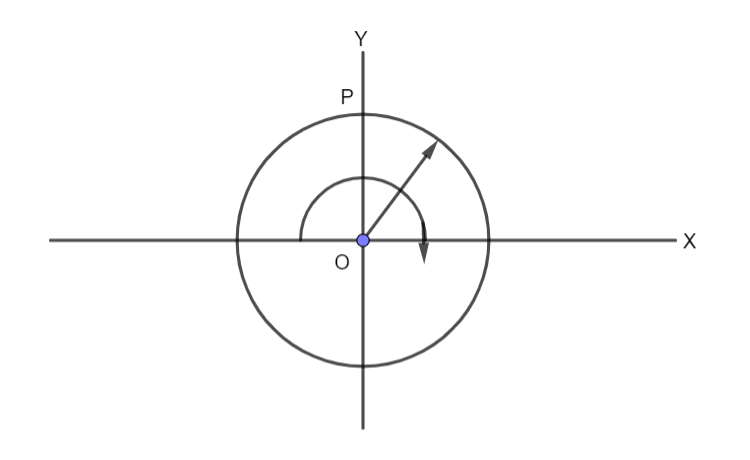
A ring rotates about the z axis as shown in the figure. The plane of rotation is x-y. At a certain instant, the acceleration of a particle P (shown in the figure) is


Answer
401.7k+ views
Hint: In this question, we will break the given acceleration into its components- tangential and normal- and use their formulas. The tangential acceleration will be equal to the x component of the given acceleration and the normal acceleration is equal to the y component of the given acceleration. Given that the radius of the circular path is 2m, we can find out the value of angular velocity and angular acceleration by substituting the values.
Complete step by step answer:
Let the angular acceleration be
The acceleration of a particle moving in circular motion has two components.
(1) Tangential acceleration: The acceleration that acts along the tangent. This is generally denoted as
(2) Normal or centripetal acceleration: The acceleration acting radially inwards towards the center of the circular path described by the body. This is generally denoted as
At point P, the tangential acceleration will be equal to the x component of the given acceleration and the normal acceleration is equal to the y component of the given acceleration.
Hence, we can say that
Given that the radius of the circular path is 2m, we can find out the value of angular acceleration.
Substituting the values, we get,
Also, we can say that
Given that the radius of the circular path is 2m, we can find out the value of angular velocity.
Substituting the values, we get,
This gives us
Note:Here we did not take into account the vectorial notation of accelerations. Acceleration being a vector must be given some direction. However, in this question, the components were already given and hence the direction of the acceleration was also already specified. So, we directly calculated the magnitude of the angular acceleration and angular velocity from the formulas.
Complete step by step answer:
Let the angular acceleration be
The acceleration of a particle moving in circular motion has two components.
(1) Tangential acceleration: The acceleration that acts along the tangent. This is generally denoted as
(2) Normal or centripetal acceleration: The acceleration acting radially inwards towards the center of the circular path described by the body. This is generally denoted as
At point P, the tangential acceleration will be equal to the x component of the given acceleration and the normal acceleration is equal to the y component of the given acceleration.
Hence, we can say that
Given that the radius of the circular path is 2m, we can find out the value of angular acceleration.
Substituting the values, we get,
Also, we can say that
Given that the radius of the circular path is 2m, we can find out the value of angular velocity.
Substituting the values, we get,
This gives us
Note:Here we did not take into account the vectorial notation of accelerations. Acceleration being a vector must be given some direction. However, in this question, the components were already given and hence the direction of the acceleration was also already specified. So, we directly calculated the magnitude of the angular acceleration and angular velocity from the formulas.
Recently Updated Pages
Master Class 9 General Knowledge: Engaging Questions & Answers for Success

Master Class 9 English: Engaging Questions & Answers for Success

Master Class 9 Science: Engaging Questions & Answers for Success

Master Class 9 Social Science: Engaging Questions & Answers for Success

Master Class 9 Maths: Engaging Questions & Answers for Success

Class 9 Question and Answer - Your Ultimate Solutions Guide

Trending doubts
State and prove Bernoullis theorem class 11 physics CBSE

What are Quantum numbers Explain the quantum number class 11 chemistry CBSE

Who built the Grand Trunk Road AChandragupta Maurya class 11 social science CBSE

1 ton equals to A 100 kg B 1000 kg C 10 kg D 10000 class 11 physics CBSE

State the laws of reflection of light

One Metric ton is equal to kg A 10000 B 1000 C 100 class 11 physics CBSE




